13 Types of BLACK, RED And WHITE BIRDS (ID Guide With Photos)
Did you recently spot a bird that was black, red and white, and want to know what species it was?
Identifying black, white and red birds is not as easy as it seems, since there are surprisingly many birds in North America that have this color combination.
To help you identify the bird you saw, we’ll cover the most common black, white and red birds in this article.
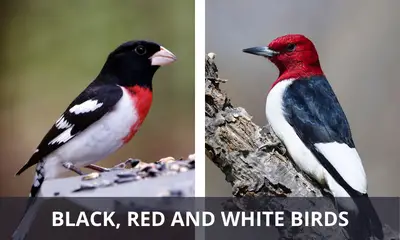
What types of birds are black, red and white?
There are 13 types of black, red and white birds, which are described in full detail below.
Note that the first 10 birds on this list live in North America, while the remaining 3 hail from other parts of the world.
Rose-breasted Grosbeak
Scientific name: Pheucticus ludovicianus
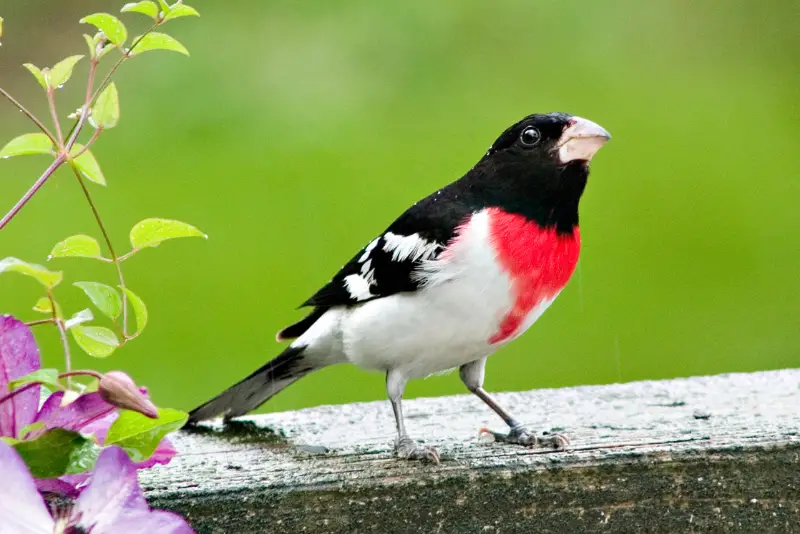
The Rose-breasted Grosbeak is easily identifiable due to its distinct markings and its large beak.
During the summer, adult males have a scarlet red chest, which contrasts with their jet black hood and white belly. Their black wings have white patches and white wing bars.
Adult females and immature birds, on the other hand, have streaked brown plumage that is lighter on the underside than on the back. They also have a white eyebrow stripe and white wingbar.
Rose-breasted Grosbeaks are summer visitors in North America from May through August.
This black, white and red bird is strictly migratory, and flies to Central America to spend the winter months.
Similar to other crossbill species, it specializes in feeding on the seeds of conifer cones.
Painted Redstart
Scientific name: Myioborus pictus

The Painted Redstart is a gorgeous wood warbler with a striking combination of red feathers contrasting with its black and white plumage.
Adult males are predominantly black with a bright red chest, white patches on the wings, white tail feathers, and a small white patch under the eye.
Adult females and young birds resemble males, but their belly is gray instead of red.
These colorful black, white and red birds can be seen in the southwestern United States during the breeding season from March through September.
After the breeding season, the Painted Redstart migrates to Central America, where it spends the winter.
Red-headed Woodpecker
Scientific name: Melanerpes erythrocephalus
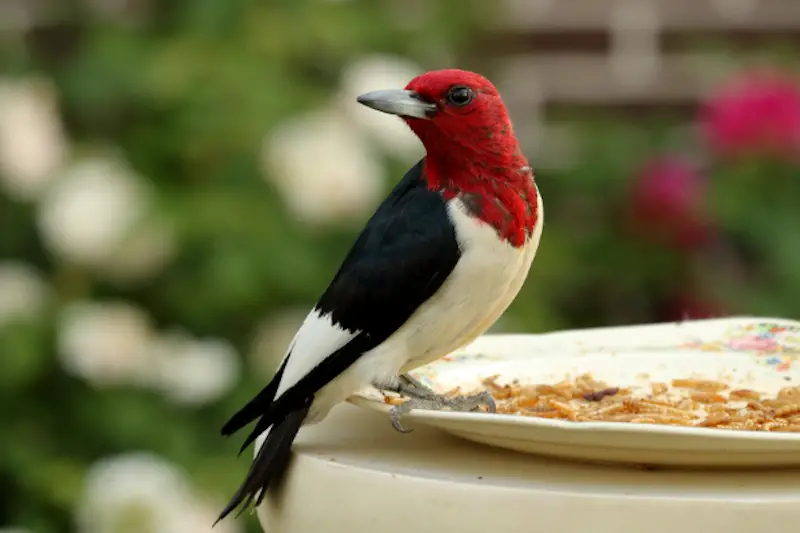
The Red-headed Woodpecker is one of the few non-dimorphic woodpeckers, which means that males and females look alike.
Red Headed Woodpeckers have an all-red head with a solid black back. They also have a white chest, rump and belly, as well as black wings and a black tail. The bill and legs are gray.
The Red-Headed Woodpecker favors wide-open deciduous or coniferous forest habitats, or forests with plenty of dead or rotten limbs.
It may use the same nest cavity for multiple years in a succession, in contrast to other woodpeckers that only use them once or for a small period of time.
This woodpecker used to be common throughout North America, but the population has unfortunately declined by more than 90 percent, and the Red-headed Woodpecker is now a rare sight in many parts of the US.
Pileated Woodpecker
Scientific name: Dryocopus pileatus
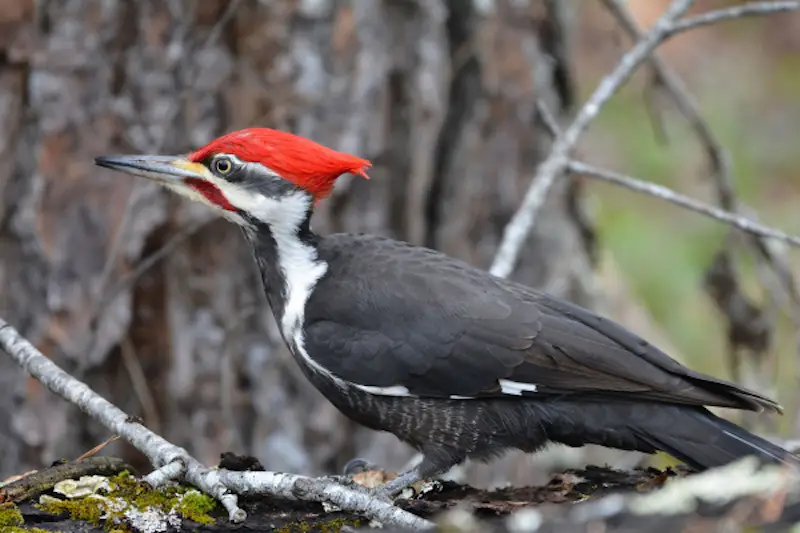
The Pileated Woodpecker is a large, crow sized woodpecker that has a bright red crest and forehead, as well as a black and white striped face and neck
The rest of this bird’s body is mostly black, although the white front edges of the wings flash brightly during flight.
The Pileated Woodpecker is the largest woodpecker in North America, and is a very shy bird that is mostly found in extensive tracts of woodland.
In order to find insects to eat, the Pileated Woodpecker drills oval holes in tree trunks that may be up to several feet long.
You can find large wood chips lying on the ground around its feeding trees, which is a tell-tale sign that Pileated Woodpeckers have been at work.
Carpenter ants are its favorite snack, and it feeds its nestlings regurgitated insects. The young woodpeckers leave the nest with pretty much the same appearance as adults.
Red-bellied Woodpecker
Scientific name: Melanerpes carolinus
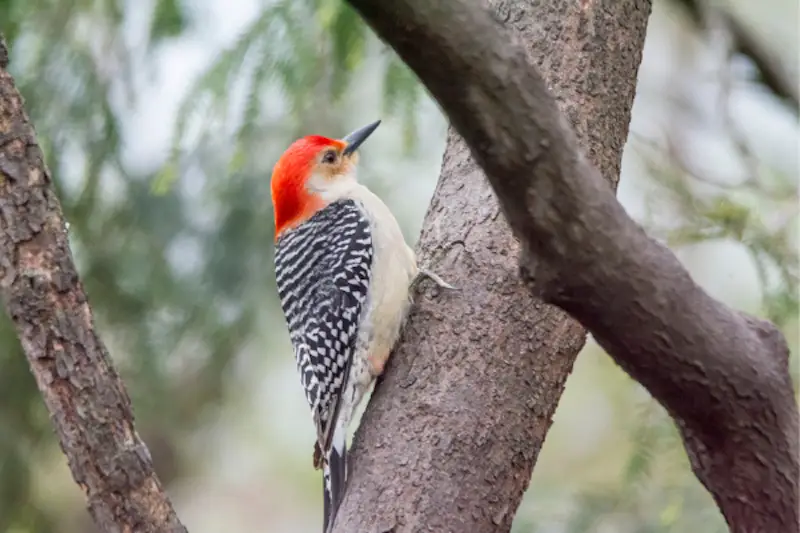
The Red-bellied Woodpecker has a black-and-white “Zebra” pattern on its back, as well as a white rump.
Males also have a red crown that goes all the way down to the base of the neck. Both sexes look similar, but the female lacks the red cap on its head.
This woodpecker favors shady woodlands, forest edges and backyards with old trees.
It excavates holes in rotting wood to locate beetles, centipedes, spiders, and other creatures.
During winter, this red, black and white woodpecker stores berries and acorns in tree crevices and cracks. Every year, it excavates a new nest below the previous one in the same tree.
While this small woodpecker is named for the rufous tinge on its belly, this can be hard to see unless you get a close up view.
Fortunately, this beautiful bird is steadily expanding its range across the whole country.
Red-breasted Sapsucker
Scientific name: Sphyrapicus ruber
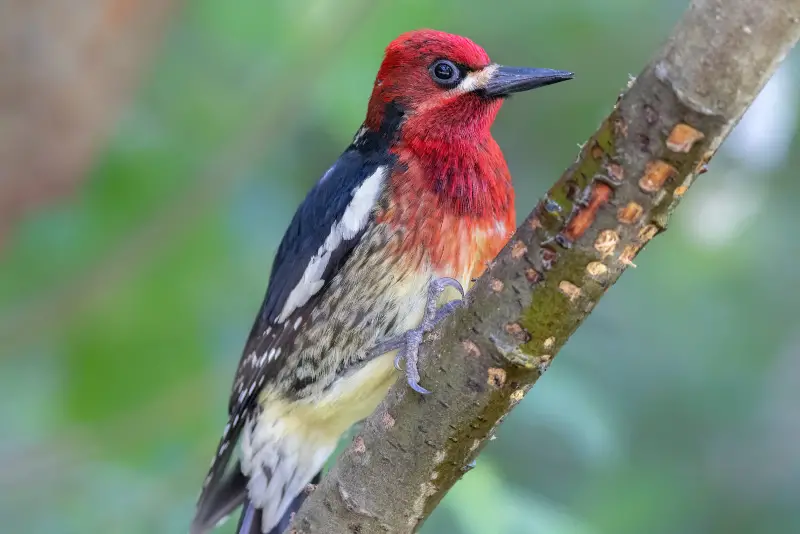
This bird is a strikingly colorful member of the woodpecker family, due to the combination of its scarlet red breast and red head with a black and white body.
The back is dark greenish black, while the belly is cream colored with dark spots and streaks. Juvenile birds look similar, but lack most of the red coloring.
These sapsuckers are birds of westernmost North America, and occur in a band along the coast from southern California all the way up to southern Alaska.
They are regular breeding birds in mixed forests, but are more common during winter, when there is an influx of northern sapsuckers that migrate to the southern United States to spend the winter.
Red-naped Sapsucker
Scientific name: Sphyrapicus nuchalis
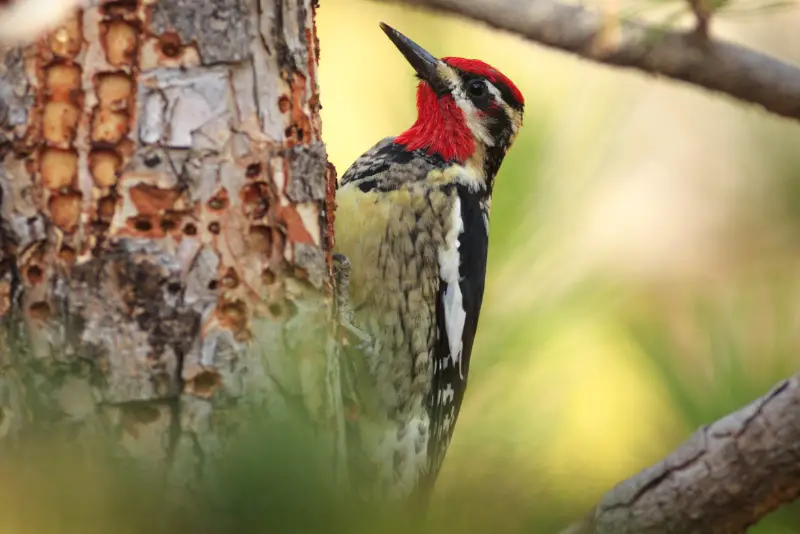
The Red-naped Sapsucker is a small woodpecker species with black and white body and red head. Adult birds have a bright red nape plus throat.
The partially red coloration on their head makes it easy to tell them apart from Red-breasted Sapsuckers, which have completely red colored heads.
The Red-naped Sapsucker is a breeding bird in the mountains of North America, and is more common during the winter months, when there is an influx of wintering birds from Canada.
Acorn Woodpecker
Scientific name: Melanerpes formicivorus
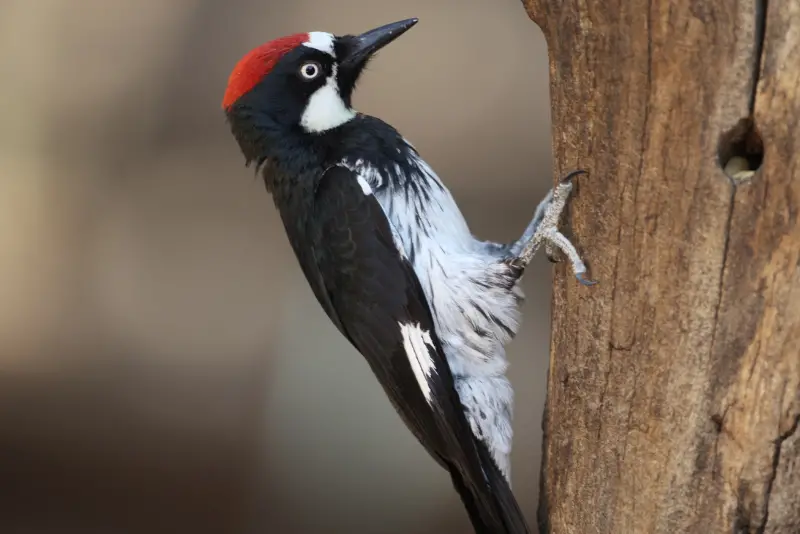
The Acorn Woodpecker is a colorful small woodpecker that only occurs in a few areas of the southwestern and western United States.
While the back and wings of these birds are entirely black, their face has a large white patch on the throat and forehead, while the belly is white with black spots.
Both sexes also have a bright red patch on top of their head, and they are usually observed as part of a social group that forages together for acorns in open oak forests.
They store their acorns in trees that are riddles with small holes created by a group of Acorn Woodpeckers. These birds also nest communally, and cooperate in raising their young.
Tricolored Blackbird
Scientific name: Agelaius tricolor
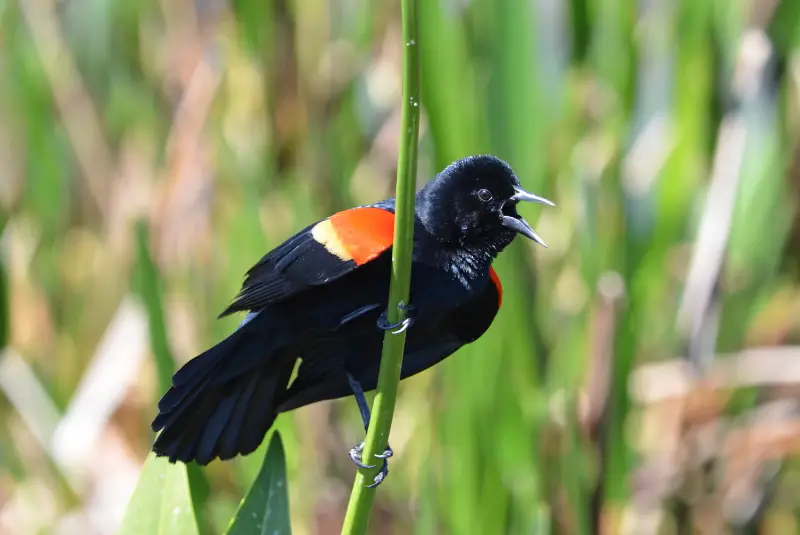
Male Tricolored Blackbirds look superficially similar to Red-winged Blackbirds. Their whole body is iridescent black, except for a small red shoulder patch with a bright white streak underneath.
They can be distinguished from Red-winged Blackbirds by virtue of their smaller crimson shoulder patch, as well as the broader white line of feathers underneath it.
Tricolored Blackbirds used to be very common in California, with flocks that numbered in the millions.
However, due to the extensive destruction of coastal swamps and marshes, they are now an endangered species, with less than forty thousand adults accounting for the entire California population.
Red-breasted Chat
Scientific name: Granatellus venustus
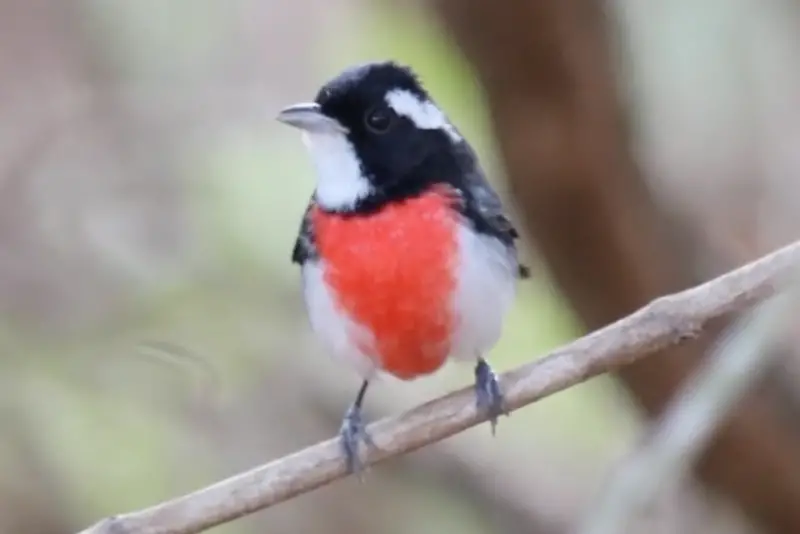
The Red-breasted Chat resembles a warbler, but is actually more closely related to grosbeaks and cardinals.
The male has a striking black head and shoulders, contrasting with its bright crimson breast. It also has a white throat and white eyebrow stripe, further adding to the color contrast.
Females and young birds are grayish brown. These birds are native to the lowlands of Central America, most notably Mexico and Guatemala.
Crimson-breasted Shrike
Scientific name: Laniarius atrococcineus
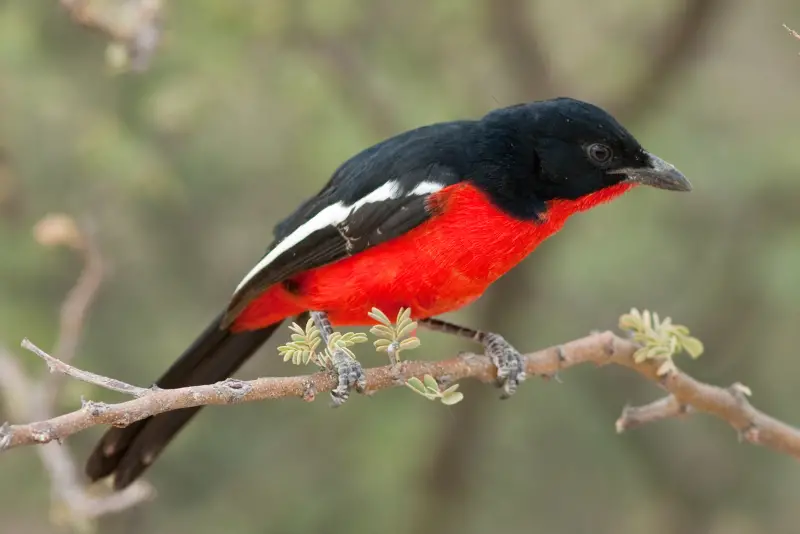
The Crimson-breasted Shrike belongs to the family of bush shrikes, and is native to South Africa.
The sexes look alike and both have jet black upper parts, including black wings and black tail, which contrast with their bright crimson underside.
They forage for insects in dry savannah and scrub land, and are regularly encountered as pairs or even small flocks.
Scarlet Robin
Scientific name: Petroica boodang
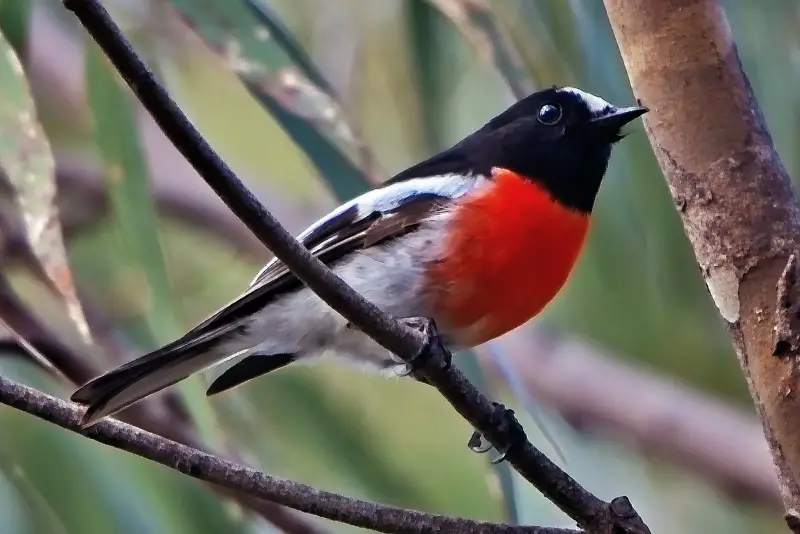
The Scarlet Robin is native to Australia, where it occurs in open forests as well as grasslands and cultivated farmland.
Males have a largely black upperside, contrasting with a bright orange chest. They also have a white forehead and white wingstripe.
Females, on the other hand, are largely gray brown, but also have a reddish orange patch on the chest.
Final remarks
In summary, here are the 13 types of white, black and red colored birds:
- Rose-breasted Grosbeak
- Painted Redstart
- Red-headed Woodpecker
- Pileated Woodpecker
- Red-bellied Woodpecker
- Red-breasted Sapsucker
- Red-naped Sapsucker
- Yellow-bellied Sapsucker
- Acorn Woodpecker
- Tricolored Blackbird
- Red-breasted Chat
- Crimson-breasted Shrike
- Scarlet Robin
If you’ve spotted one of these birds, but aren’t sure which species it was, check our detailed ID guide with photos above.
If you enjoyed this article, check out our guide to the types of birds with red bellies.

